| Gianyar
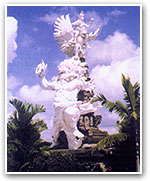 The district of
Gianyar covers nearly 36,500 hectares, a narrow strip of land
with the southern border just a few kilometers from the
outskirts of Denpasar, and the northern-most point high on the
slopes that lead to the caldera of Mount Batur. Gianyar city,
the centre of regional administration, is the capital of a
former kingdom, which covered an equivalent area of land a
thousand, or more years ago. The district of
Gianyar covers nearly 36,500 hectares, a narrow strip of land
with the southern border just a few kilometers from the
outskirts of Denpasar, and the northern-most point high on the
slopes that lead to the caldera of Mount Batur. Gianyar city,
the centre of regional administration, is the capital of a
former kingdom, which covered an equivalent area of land a
thousand, or more years ago.
Nearly half of the district is covered in
lush sawah rice fields, fed by the springs that filter down
from the base of the dormant volcano, filling the streams that
run through gorges and meander through valleys and fields,
distributing life-giving water to a magnificent series of
paddy terraces throughout the territory before into the sea
along the 30 kilometer stretch of sandy coastline. The River
Ayung form a natural border along the western side of the
territory with the district of Badung in the west. The eastern
border with Bangli and Klungkung districts is a line drawn by
the Pakrisan river to the north and the Melangit river to the
south.
Seat of Historic
Dynasties
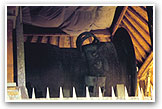 Steeped in
history and culture, the district of Gianyar is full of
archeological relics of the past. Folk tales have grown up
around the discovery of a solid bronze drum resembling those
of the Vietnamese Dong Son bronze age around 1000 BC, supposed
to have been a bright moon which fell to the ground, fondly
called the "Moon of Pejeng" by all Balinese. Other bronze-age
statues, rock inscriptions and folk tales testify to a highly
developed culture in the past. Steeped in
history and culture, the district of Gianyar is full of
archeological relics of the past. Folk tales have grown up
around the discovery of a solid bronze drum resembling those
of the Vietnamese Dong Son bronze age around 1000 BC, supposed
to have been a bright moon which fell to the ground, fondly
called the "Moon of Pejeng" by all Balinese. Other bronze-age
statues, rock inscriptions and folk tales testify to a highly
developed culture in the past.
Further legends are told about the
Javanese priest, Resi Markendeya, who came as an emissary of
Hinduism from the great Kingdoms of Java to Bali during the
8th Century, and initiated the building of the
Gunung Lebah temple in Ubud, Pura Gunung Raung in Taro, and
Pura Besakih on the slopes of Mt. Agung.
During the 9th Century the
Warmadewa Dynasty was in power in Bali, a dynasty of twins,
brother married to sister, who ruled in the manner of
God-Kings from the Singha Mandawa Kingdom on the banks of the
Pakrisan River. This was a golden age of development for Bali,
with the coming of Hinduism, a flowering of religion,
architecture and art.
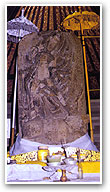 Udayana, fourth
generation ruler of the Warmadewa Dynasty, ruled over Bali in
1011, at a time when the Kingdoms of East Java were at their
peak. He married Mahendratta, East Javanese princess, forging
an indelible link with Java. This queen buried on the hill of
Bukit Dharma in the village of Kutri just 5 kilometers from
Denpasar. This queen was supposed to have been the
manifestation of Durga, the Goddess of death, and at Durga
Kutri, her burial place, can be seen a stone statue of Durga
on the back of the bull, Nandini. She is identified as the
witch in the Calon Arang story, the evil Rangda of Balinese
mythology. Udayana, fourth
generation ruler of the Warmadewa Dynasty, ruled over Bali in
1011, at a time when the Kingdoms of East Java were at their
peak. He married Mahendratta, East Javanese princess, forging
an indelible link with Java. This queen buried on the hill of
Bukit Dharma in the village of Kutri just 5 kilometers from
Denpasar. This queen was supposed to have been the
manifestation of Durga, the Goddess of death, and at Durga
Kutri, her burial place, can be seen a stone statue of Durga
on the back of the bull, Nandini. She is identified as the
witch in the Calon Arang story, the evil Rangda of Balinese
mythology.
The royal tombs of Udayana on the banks of
the Pekrisan River, became the Buddhist hermitage of Gunung
Kawi, and the rock faces of the George are a massive feat of
stone carving. The entire valley is dotted with tombs,
residences and meditation caves, scattered amongst
breath-taking rice terraces that pave the hillsides’ steep
descent.
Anak Wungsu, the younger son of Udayana,
inherited the Kingdom in Bali, and his older brother Airlangga
went on to rule East Java as inheritor from his mother’s
side.
The next three generations saw the rise
and fall of many Kingdoms in Java, but Bali was little
affected till the Majapahit Dynasty began to develop in power
and conquer far flung parts of the archipelago which for the
first time became united under a common ruler, including
Bali.
Prior to the interference of Majapahit,
Bali was ruled by Raja Sri Aji Asura Bumi Banten and his
minister Kebo Iwa, from their palaces in the village of
Bedahulu. The Raja was a tyrant, and folk tales depict him as
an ugly man with a pig’s head. Kebo Iwa was supposed to have
possessed supernatural power with which he built several
temples all by himself, taking only a couple of nights to
complete the feat. Folk tales portray him as a giant with long
fingernails with which he could carve a rock face.
The Majapahit Empire appointed Sri Kresna
Kepakisan to rule over Bali. He built a palace at Samprangan,
near Gianyar, which duly passed on, to his son, a most
ineffective fellow. The younger brother, Ketut Ngelisir, left
the region and established a separate palace in Gelgel, near
Klungkung, from whence he was able to usurp his brother’s
failing powers and rule Bali independently.
The history of the city and kingdom of
Gianyar, as with most history in Bali, is based upon legend
and the genealogical "babad" stories recorded in the Balinese
lontar manuscripts. The name Gianyar is thought to have
derived from the words Griya meaning "priest’s house" and
Anyar meaning "new", possibly referring to the site upon which
the original palace of Gianyar was built. The Raja of Gianyar
was known as Dewa Manggis, and his Kingdom emerged as a
distinct power in the 18th century, prior to which
his realm belonged to neighbouring kingdoms. By the beginning
of the 19th Century the Dewa Agung of Klungkung had
lost most of his power through warring with neighboring
Karangasem and Lombok. The subsidence of the powers of
Klungkung afforded an opportunity to the ambitious local
Panggawa of the village of Gianyar, who by means of deceit,
poisonings and war was able to overpower his neighboring lords
and gain control over a large area. This was the first Dewa
Manggis. He was unpopular, and considered an upstart by the
other Rajas. His ambitions led to a period of confused warring
between the other southern kingdoms, which gave the Dutch, who
had for some time been trying to gain control, increasing
opportunity to become involved. The warring reached a peak in
the 1890’s when Dewa Manggis VII, deeply in trouble, decided
to submit to the ruling Dewa Agung. He was imprisoned, and the
Kingdom of Gianyar was shared out between Klungkung and
Mengwi.
It was not long, however, before Tabanan
and Badung conquered Mengwi and redivided the defeated kingdom
amongst themselves. Two sons of Dewa Manggis VII managed to
escape from Klungkung in 1889 and enlisted the help of Cokorda
Sukawati of Ubud to reestablish their kingdom of
Gianyar.
Fearing further opposition, the new Dewa
Manggis allied himself with the Dutch, and in 1900 Gianyar was
accepted as a Dutch Protectorate. Under this arrangement
Gianyar prospered, as the Dutch continued their efforts to
subdue the rest of southern Bali. The palace of Puri Gianyar
became an elite centre of social life, with the effect that
the arts of the area received more attention and royal
patronage than ever before, and a great blossoming of artistic
activities took place within the region. During this time
western artists Walter Spies and Rudolf Bonnet came to live in
the area and also greatly influenced the development of the
arts.
The Javanese occupation in Bali in 1942
brought a temporary halt to this. Close on the heels of
Hiroshima and Nagasaki bombings, Soekarno and Hatta proclaimed
the Independence of the republic of Indonesia. The Dutch
powers tried to return to enlist the help of their old allies
in Gianyar, but to little avail.
Archeological
Treasures
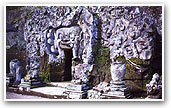 The Regency of
Gianyar is full of archeological reminders of its spectacular
history. Goa Gajah, the "Elephant Cave" is one of the most
visited historic sites of Bali. Rediscovered in 1923, this
T-shaped cave houses three lingga stones symbolic of Siva, and
is thought to have been for meditation. The cliff face out of
which it has been hewn is carved into a representation of the
guardian Bhoma, the mouth of which is the entrance to the
inner passage. In 1954 adjacent baths were discovered and
excavated, disclosing a row of beautifully sculpted female
figures, each pouring water from an urn. The Regency of
Gianyar is full of archeological reminders of its spectacular
history. Goa Gajah, the "Elephant Cave" is one of the most
visited historic sites of Bali. Rediscovered in 1923, this
T-shaped cave houses three lingga stones symbolic of Siva, and
is thought to have been for meditation. The cliff face out of
which it has been hewn is carved into a representation of the
guardian Bhoma, the mouth of which is the entrance to the
inner passage. In 1954 adjacent baths were discovered and
excavated, disclosing a row of beautifully sculpted female
figures, each pouring water from an urn.
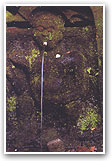 The stone
relief’s of Yeh Pulu, another ancient work of art of
mysterious origins, can be found between Goa Gajah and Bedulu. The stone
relief’s of Yeh Pulu, another ancient work of art of
mysterious origins, can be found between Goa Gajah and Bedulu.
These are thought to date back to a
14th century monastery. Yeh Pulu is now a small
temple, entirely walled on one side by a carved stone frieze
25 meters in length representing an episode from the story of
Krishna.
The Gedong Arca Museum, an archeological
museum with a collection of Stone Age heads, bone ornaments,
weapons, earthenware and ceramic pots, bronze artifacts, stone
sarcophagi and fossils, is situated just north of Bedulu on
the Tampaksiring road. A branch of the Department of
Archeology here can supply information on current
archeological activities in Bali.
The famous pre-Hindu bronze kettledrum is
housed at Pura Penataran Sasih, which was once the state
temple of Pejeng. This relic is the lone survivor of its type
from the Bronze Age, dated around 300 BC, and is thought to be
the largest drum in the world to be cast in a single piece.
The drum is of a rare type, shaped like an hourglass and
several meters in length, with stylized faces and ornaments
carved on its surface.
Important relics of the past are found in
there other nearby temples. In Pura Kebo Edan (the temple of
the crazy buffalo) there are a number of ancient stone
statues, the most spectacular of the warrior Bima wearing a
mask, with snakes coiling around his legs, a rare relic of the
Bhairawa Tantric Buddhist sect which existed in Bali prior to
the 11th Century. The Pura Pusering Jagat (the
temple of the Navel of the World) houses a carved stone vessel
that tells the story of the churning of the ocean by the gods
and demons searching for the elixir of life. Another ancient
monastery known as Goa Garba can be found in the ricefields
just two kilometers east of Pejeng.
The village of Bedulu, named after the
ancient tyrant who had the head of a pig, has an ancient
temple complex, Pura Samuan Tiga that was built in the
11th century.
A steep descent via hundreds descent via
hundreds of steps into the George of the Pakrisan river leads
to the royal tombs and hermitage of Gunung Kawi, carved out of
the rock face around the same period.
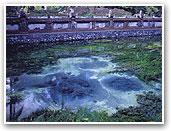 A little
further up the valley, just past the village of Tampaksiring,
the road winds down to the head of the valley whence gushes
the holy springs of Tirta Empul. The legend of this spring is
centered around the evil Maya Danawa, a demon king who refused
to allow his people to worship God because he believed he was
the most Supreme Being of all. A mission from the gods was
sent to put matters right, but Maya Denawa poisoned the
drinking water of the heavenly troops. In order to save them
the God Indra shot a magic arrow into the ground from which
appeared a healing spring, the Tirta Empul. A temple surrounds
the holy springs, with a large shrine to the God Indra, and
there are bathing pools which are supposed to have strong
curative powers. On the hill behind this temple is a
presidential guesthouse built by the late President Soekarno. A little
further up the valley, just past the village of Tampaksiring,
the road winds down to the head of the valley whence gushes
the holy springs of Tirta Empul. The legend of this spring is
centered around the evil Maya Danawa, a demon king who refused
to allow his people to worship God because he believed he was
the most Supreme Being of all. A mission from the gods was
sent to put matters right, but Maya Denawa poisoned the
drinking water of the heavenly troops. In order to save them
the God Indra shot a magic arrow into the ground from which
appeared a healing spring, the Tirta Empul. A temple surrounds
the holy springs, with a large shrine to the God Indra, and
there are bathing pools which are supposed to have strong
curative powers. On the hill behind this temple is a
presidential guesthouse built by the late President Soekarno.
A Legacy of
Creativity
The path through the region of Gianyar
runs a regular gamut of art studios, art shops and cottage
industries. Most village have their own specialty, as creative
pursuits are generally community activities that have been
passed down from generation to generation.
Batubulan
 This village is
the first on the route from Denpasar, and its name "moon
stone" is indicative of the predominant craft in the village,
that of stone carving. The art of Batubulan can be seen all
over the island in temples, shrines, at bridges, houses, and
even in hotels, in soft stone sculptures and carvings, images
of gods and demons, warrior-guards and even animals. The main
road through the village itself is lined with workshops and
stone creatures of all sizes and shapes peep from the
sidelines. The famous Barong and Kris Dance is also performed
here there are several different groups performing daily, each
at a different temple pavilion or banjar, from 9.0 to 10.0
a.m. This village is
the first on the route from Denpasar, and its name "moon
stone" is indicative of the predominant craft in the village,
that of stone carving. The art of Batubulan can be seen all
over the island in temples, shrines, at bridges, houses, and
even in hotels, in soft stone sculptures and carvings, images
of gods and demons, warrior-guards and even animals. The main
road through the village itself is lined with workshops and
stone creatures of all sizes and shapes peep from the
sidelines. The famous Barong and Kris Dance is also performed
here there are several different groups performing daily, each
at a different temple pavilion or banjar, from 9.0 to 10.0
a.m.
Celuk
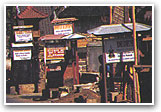 The silver and
goldsmiths of Celuk, long famed for their delicate work, are
in the mid of a great bustle of production, as orders for
export of contemporary jewellery have more than quadrupled in
the past few years. The skills of the Celuk artisans are such
that they can move effortlessly from their traditional art of
highly decorative filigree ornamentation to the streamlined
geometrical shapes of today, creating contemporary pieces that
are popular the world over. The cottage industry has spread
through the entire village, far beyond the rows of ornate art
shop buildings that front the main road, to the family
compounds, where children work beside their elders, learning
the skills of the art from a very young age. The silver and
goldsmiths of Celuk, long famed for their delicate work, are
in the mid of a great bustle of production, as orders for
export of contemporary jewellery have more than quadrupled in
the past few years. The skills of the Celuk artisans are such
that they can move effortlessly from their traditional art of
highly decorative filigree ornamentation to the streamlined
geometrical shapes of today, creating contemporary pieces that
are popular the world over. The cottage industry has spread
through the entire village, far beyond the rows of ornate art
shop buildings that front the main road, to the family
compounds, where children work beside their elders, learning
the skills of the art from a very young age.
Sukawati
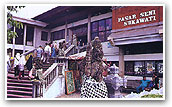 The sprawling
village of Sukawati is famous for its "Dalangs " the shadow
Puppet masters of the Wayang Kulit shadow theatre. There is a
large art market here, the Sukawati Pasar Seni, where all
kinds of handicrafts can be purchased at reasonably cheap
prices. A wide range of souvenirs of Bali are available both
in finished and semi- finished state, and a lot of art dealers
purchase their stocks wholesale here. The sprawling
village of Sukawati is famous for its "Dalangs " the shadow
Puppet masters of the Wayang Kulit shadow theatre. There is a
large art market here, the Sukawati Pasar Seni, where all
kinds of handicrafts can be purchased at reasonably cheap
prices. A wide range of souvenirs of Bali are available both
in finished and semi- finished state, and a lot of art dealers
purchase their stocks wholesale here.
Batuan
Known for is dancing, and the originality
of its painters and wood-panel carvers. Batuan has long been a
famous centre of the arts. There are active Topeng, Legong and
Gambuh.
Dance troupes here, and many young
foreigners come to Bali to study dance in this village. The
carved wooden friezes are replicas of the detail found in
stone temple walls, depicting scenes from the ancient
Mahabharata and Ramayana epics in exquisite detail. Several of
Batuan ‘s best painters exhibit their work in Ubud’s Puri
Lukisan and some have exhibited overseas. Few artists in Bali
are so well traveled as Batuan’s Made Budi, who sees the world
in is own inimitable expressly Balinese manner. He is a wizard
at depicting the contrasts of modern Bali in humorous detail
on the canvas: antiquity side by side with contemporary,
visitor and local, prayer and profanity.
Mas
Just a few kilometers past Batuan the road
turns eastwards to Gianyar, or northwards to the village of
Mas, Peliatan and Ubud. Mas, the home of some of Bali’s most
famous woodcarvers, is a village well worth visiting. The
studio of Ida Bagus Tilem, master woodcarver, is a showroom of
antique and modern woodcarving, and he has a permanent
exhibition of his own priceless sculptures that are timeless
works of art. Visit the homes of Ida Bagus Gelodog and Ida
Bagus Anom, two of the most famous mask-carvers in Bali. There
are many home studios in the village, where one can watch
artisans at work, bringing the specially chosen pieces of wood
to life with skillful strokes of the chisel.
Teges
At Teges the road branches again, to Ubud
on the left, or Goa Gajah to the right. This village has two
communities, Teges Kanginan, famous for its musicians and
dancers, and Teges Kawan, a community of sculptors. The Teges
Kanginan community have a large Semar Pegulingan Orchestra, a
Kebyar Orchestra, a children’s gamelan and an Angklung bamboo
ensemble, and their dancers are the primadonnas of the
Balinese stage. The original Kecak dance was choreographed in
this village. The wood carvers of Teges Kawan specialize in
contemporary ornamental and functional carvings. They create
replicas of trees, plants, flowers, ducks, fish and fruits
that make interesting pieces for interiors. Each carving is
painted in lifelike colors, so realistic they will confuse the
casual observes.
Pengosekan
Just off the main road through Peliatan,
this small village became famous when Queen Elizabeth visited
in 1974. Pengosekan has an active Community of Artists, with a
studio near the main road, who work together under the
guidance of Dewa Nyoman Batuan, who is himself an accomplished
artist. The Pengosekan artists create attractive compositions
and scenes from nature in pastel shades that delight the eye.
They also have a group who carves furniture, trays, cupboards
and other household utensils in shallow relief, to which the
artists apply, a delicate rendering of colour. Within the
village are many smaller home studios.
Nyuh
Kuning
Past Pengosekan the road meanders through
the rice fields to the sacred Monkey Forest just south of
Ubud, where there is a secluded bathing place in a deep ravine
bridged by the roots of a huge Banyan tree. Above the Monkey
Forest is a forbidding temple with striking sculptures of the
evil witch Rangda, devourer of children, guarding the inner
temple. The village of Nyuh Kuning is close by, yet another
community of farmers who sculpt and paint in their spare time,
creating statues of birds, frogs, fish and insects, and
detailed canvas renderings of nature’s
wonders.
Peliatan
Famed for its fine gamelan players and
legong dancers, Peliatan is the home of Bali’s first dance
troupe to perform abroad. In the early 1950’s the original
group, led by the late Anak Agung Mandera, visited Paris,
London, New York and Hollywood, where they starred in the
Paramount production "Road to Bali" along with Bing Crosby,
Bob Hope and Dorothy Lamour. The younger generations are still
active and apart from weekly performances in the village they
also perform frequently at the International
hotels.
Ubud
The peaceful village of Ubud takes it’s
name from the Balinese word "Ubad" which means "medicine", as
the original pilgrims who founded the village found the nearby
forest to be full of medicinal herbs. In the last fifty years
this village has developed into a tourist resort. At the
centre of the village is a crossroad, with the Royal Puri Ubud
on one corner and the community hall and theatre opposite.
Across the road from the palace is a new shopping centre and
market. The Ubud market comes alive every three days when
villagers come from near and far to sell their produce. About
one hundred meters to the west of Ubud’s market is the tourist
information centre run by the Bina Wisata Foundation,
volunteer youths from the village who speak good English and
give free information about events and places of interest
within the surrounding area, as well as assisting hotel and
performance reservations. The Puri Lukisan Museum of Ubud,
another 100 meters down the road, houses a permanent
exhibition of the finest work of many artists, ranging from
the traditional Wayang style to work from the early thirties
and a selection of the finest work of local artists. There is
another outstanding collection of art to be found at the Neka
Museum, several kilometers further north, which has an
adjacent showroom with many choice exhibits that are for
sale.
Campuhan
The meeting of two rivers, deep in the
valley forms a narrow platform where the ancient temple Pura
Gunung Lebah was built by the Hindu priest Resi Markandeya, in
the 8th Century.
Penestanan
Just over the hill to the west of
Campuhan, a scenic hike of one kilometer through the rice
fields, is the village of Penestanan with its school of "naïve
painting" in bright colours, a style fostered by the influence
of Arie Smith, a Dutch artist who has lived most of his life
in Bali. Known as the "Young Artist" style, this art is highly
decorative and simplistic.
Pujung and
Sebatu
The villages the Pujung and Sebatu, just a
few kilometers past the turnoff into the village of Ubud, are
both communities of wood-carvers. After the morning’s work in
the rice fields the farmers busy themselves creating
expressive carvings and huge garuda statues that are
delicately painted in bright colours. There are springs at the
temple of Gunung Kawi and this is popular-bathing
place.
Taro
Coffee plantations over the land around
Taro. And the classics Balinese architecture of the compounds
are reminiscent of the Bali of the past.
Sayan
For stunning views the village of Sayan is
unsurpassed. The village backs onto ravine that drops far down
into a deep valley carved by the Ayung River. Over the past
twenty years a number of foreigners have built holiday homes
along the ridge, looking out over the spectacular view to the
mountains of west Bali in the distance.
Payangan
The village of Payangan, just twelve
kilometers past Ubud, is famous for its lychees, durian and
pineapples. Just north of Payangan is a village called
Tihingan, with beautiful bamboo groves. This is a particularly
beautiful part of Bali for countryside
walks.
Kedewatan
Behind the village of Kedewatan the ridge
looks over the curving valley of the Ayung River, and here are
cottages and swimming pools, and even a small restaurant,
perched of the ridge top taking advantage of the splendid
view.
Blahbatuh
At the corner of the main crossroad in
Blahbatuh is the local puri, which has a great collection of
orchids and is open to visitors. The only gong-maker in the
regency of Gianyar is at nearby Banjar Babakan. Gamelan
instruments of all kinds are made here.
Belega And
Bona
The road to the east of Blahbatuh passes
through Belega and Bona on a back route to Gianyar. Belega and
Bona both have many bamboo furniture workshops, and great deal
of their work is for export. In Bona women and children of all
ages make delicate basketry cleverly women and dyed in bright
colours.
Tampak
Siring
The road to Tampak Siring passes the
archeological monuments of Goa Gajah, Yeh Puluh and Pejeng
mentioned of the previous pages .In the villages near Gunung
kawi and Tirta Empul can be found bone and ivory carving of
exquisitely fine detail. Coconut shells are also carved into
pretty lampshades, and hand-painted wooden jewellery is a
prospering handicraft, produced to order for export. Many of
the women spend their idle hours, whilst minding their
souvenir shops and kiosks, at crochet, making fine
tablecloths, bed covers and apparel.
The City of
Gianyar
The
place of Gianyar, surrounded by towering brick walls, looks
out over the Town Square, dominating the landscape with its
grand architecture. Gianyar is bustling market town, famous
for its Babi Guling, roast-suckling pig, which is sold at
stalls in a small enclave at the centre of the Town. Bukit
Jati swimming pool is just three kilometers to the east. On
the western borders of the town can be found numerous weaving
and tie-dying factories, which are interesting to visit.
Simple techniques are used to produce the exquisite Balinese
sarongs and hand-woven or hand-dyed cloth can be purchased by
the meter. Gianyar is criss-crossed with a maze of tiny roads
and villages and the industrious creativity of the people is
amazing. Handicrafts are cleverly adapted to meet the demand
for souvenirs and exports by the skillful artisans of the
area, new ideas appearing every day in response to popular
demand.
|

